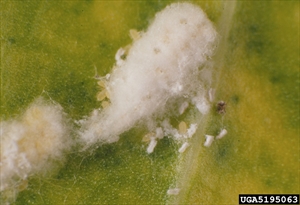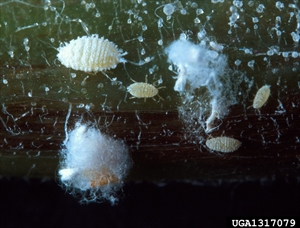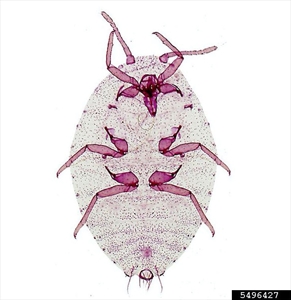Papaya mealybug
Pacific Pests, Pathogens, Weeds & Pesticides - Online edition
Pacific Pests, Pathogens, Weeds & Pesticides
Papaya mealybug (328)
Paracoccus marginatus
South and Southeast Asia, Africa, North (Hawaii), South and Central America, the Caribbean, Middle East, Oceania. It is recorded from Australia, Federated States of Micronesia, French Polynesia, Guam, Marshall Islands, Northern Mariana Islands, Palau, and Papua New Guinea.
Many plant species are hosts, including many economically important fruit trees and ornamentals, such as: avocado, beans, cassava, citrus, coffee, cotton, eggplant, frangipani, gardenia, hibiscus, mango, papaya, pea, sweet potato, tomato, and more. Numerous weeds are also hosts.
A mealybug that causes severe infestations of papaya and other hosts by feeding on fruits and stems, resulting in yellowing, stunting, deformed leaves (Photo 1), and fruit drop. Fruit becomes covered in crusts of mealybugs and waxy secretions (Photo 2), and the latter are common on leaves and stems, too (Photo 3). As the mealybug feeds on sap it expels liquid which falls onto leaves and attracts growth of dark fungi which prevent the leaves functioning normally.
The adult female is yellow, approximately 2.2 mm long and 1.4 mm wide, covered with a white waxy coating, and short waxy filaments, less than 1/4 the length of the body around the margin.
Eggs (up to 600) are laid into an egg sac underneath the female. The nymphs or 'crawlers' (Photo 4) of both sexes go through several moults; females develop as mealybugs, males develop into fly-like insects with wings. Males have no mouthparts, and their only function is to mate, and then die.
Spread occurs when crawlers move over short distances or longer in wind currents, on clothing, vehicles, animals, birds, and in the trade in fresh fruit.
Heavy infestations on papaya fruit result in build-up of a thick layer of mealybugs and white wax, and the fruit become inedible. The black stains on the fruit caused by sooty mould growth prevent sales on local and export markets. On the leaves, the sooty moulds reduce exchange of gases and photosynthesis.
Ducts, pores, and arrangement of hairs are important in distinguishing this mealybug from other Paracoccus and closely related species. Expert identification is required, observing characteristics of adult females, mounted on slides, guided by a taxonomic key.
A quick test for the mealybugs involves placing them in 80% alcohol for 24-48 hours when they turn black.
Distinguishing between papaya and the hibiscus mealybug (Maconellicoccus hirsutus) is based on the number of segments of the antennae: the female papaya mealybug has eight segments, whereas the hibiscus mealybug has nine. Also, when squashed on paper, Paracoccus marginatus is yellow, whereas Maconellicoccus hirsutus is pink.
QUARANTINE
Although widely distributed, there are countries, especially in the South Pacific, vulnerable to introduction of Paracoccus marginatus. Therefore, it is necessary to prevent this mealybug from extending its range. Biosecurity authorities need to be alert to the fact that movement of this pest across national borders is associated with the trade in nursery plants, fruit, and cut flowers. A Threat Specific Contingency Plan Papaya mealybug Paracoccus marginatus (2011) has been prepared by Plant Health Australia (http://www.planthealthaustralia.com.au/wp-content/uploads/2013/03/Papaya-mealybug-CP-2011.pdf).
NATURAL ENEMIES
Natural enemies of the papaya mealybug include the generalists, e.g., ladybird beetles (including the so-called 'mealybug destroyer', Cryptolaemus montrouzieri), lacewings, and hover flies. There are also several specific parasitoid wasps, that have brought infestations under control in several countries in the Caribbean, South America, and the Pacific. The most efficient are, Acerophagus papayae, Anagyrus loecki, Anagyrus californicus and Pseudleptomastix mexicana. Acerophagus papayae seems to be the most effective.
CULTURAL CONTROL
Generally, this is not a method for the control of this pest. However, practices, such as removal of host weeds and, importantly, control of ants associated with infestations, pruning low branches - to prevent foraging by ants - and those heavily infested, may help manage Papaya mealybug once established.
CHEMICAL CONTROL
The release of parasitoids has proved very successful wherever tried against this mealybug and, once released, insecticides use should be avoided. Their use can make the problem worse by destroying biocontrol agents, parasites and predators. If a pesticide is required, the following are recommended:
Use horticultural oil (made from petroleum), white oil (made from vegetable oils), or soap solution (see Fact Sheet no. 56). The spray will not kill all mealybugs, but it will suppress the population enough to allow predator and parasite numbers to build up and start to control them.
- Several soap or oil sprays will be needed to bring the mealybugs under control. It is essential that the underside of leaves, stems, and the surface of fruits are sprayed thoroughly. It is best to spray between 4 and 6 pm to minimise the chance of leaves becoming sunburnt.
- White oil:
- 3 tablespoons (1/3 cup) cooking oil in 4 litres water
- ½ teaspoon pure hand soap, not detergent
- Shake well and use.
- Soap:
-
Use soap (pure hand soap, not detergent).
- 5 tablespoons of soap in 4 litres water.
-
- White oil:
- Commercial horticultural oil can also be used. Note, these sprays work by blocking the breathing holes of insects causing suffocation and death. They are less likely to kill natural enemies as they are quickly broken down in the environment, and also the development of resistance to them is less likely than is the case when using synthetic pesticides. If destruction of natural enemies is not a concern add malathion or a synthetic pyrethroid that is inactivated rapidly in the environment.
- Use synthetic pyrethroid insecticides to kill ants, which often tend mealybugs for their honeydew, and protect them from effective control by predators and parasitoids.
____________________
When using a pesticide, always wear protective clothing and follow the instructions on the product label, such as dosage, timing of application, and pre-harvest interval. Recommendations will vary with the crop and system of cultivation. Expert advice on the most appropriate pesticide to use should always be sought from local agricultural authorities.
AUTHOR Grahame Jackson
Information from Walker A et al. (2018) Papaya mealybug, Paracoccus marginatus Williams and Granara de Willink (Insecta: Hemiptera: Pseudococcidae). EDIS, University of Florida IFAS Extension. (https://edis.ifas.ufl.edu/in579); and CABI (2017) Paracoccus marginatus (papaya mealybug) Crop Protection Compendium. (https://www.cabi.org/cpc/datasheet/39201); and from Paracoccus marginatus. Wikipedia. (https://en.wikipedia.org/wiki/Paracoccus_marginatus). Photo 1 Peggy Greb, USDA Agricultural Research Service, Bugwood.org. Photo 2 Jeffrey W. Lotz, Florida Department of Agriculture and Consumer Services, Bugwood.org. Photos 3&4 Dale E. Meyerdirk, USDA APHIS PPQ, Bugwood.org. Photo 5 Alessandra Rung, California Department of Food & Agriculture, Bugwood.org.
Produced with support from the Australian Centre for International Agricultural Research under project PC/2010/090: Strengthening integrated crop management research in the Pacific Islands in support of sustainable intensification of high-value crop production, implemented by the University of Queensland and the Secretariat of the Pacific Community.








